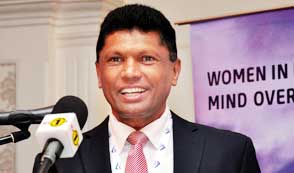Monday Apr 07, 2025
Monday Apr 07, 2025
Monday, 9 May 2016 00:00 - - {{hitsCtrl.values.hits}}
 By Shehana Dain
By Shehana Dain
Contrary to negative views from various parties, Sri Lanka Ports Authority Managing Director H. D. A. S Premachandra insisted that the proposed East Container Terminal (ECT) will be a lucrative.
Premachandra was critical against the views of certain individuals who he claims are “ex-spurts.”
“When I say ex-spurts the meaning of ex refers to has been and no more, they are not experts. This kind of viewpoints expressed by individuals who have no knowledge of the industry can do very serious damage to the port of Colombo,” he stressed.
There has been a growing concern with regard to the expansion of the Colombo port due to already available excess capacity while many have been puzzled as to why the port should add more capacity when its already underutilised.
Currently the capacity of the Colombo harbour is 7.0 M twenty foot equivalent units (TEU) but demand is 5.3 M TEU.
Premachandra who admitted that the port is underutilised was positive that the disparity of demand and supply can be curbed. He pointed out that the infrastructure of the ECT concentrates on market trends which are inclined towards growth in of large vessels rather than mere volumes.
“We can match the two sides of demand and supply. There has been a leap of 400 ships from 2014 to 2015, ship traffic is growing rapidly. The requirement for deep draft berths which can allow beyond 14.25 meter vessels is very important because the South Asia Gateway Terminals (SAGT) and Jaya Container Terminal (JCT) have a limitation berthing ships beyond this draft and Colombo International Container Terminal (CICT) is the only terminal that can. Therefore we are seeing exponential growth of large ships and this would determine whether we should take the next leap or not, he said.
Moreover Container handling at the Colombo Port is carried out by the SLPA, SAGT and CICT. With the opening of the South Terminal by the end of 2014 containers handled by the Colombo Port increased by 14% to 4.9 million TEUs.
The performance compares with an annual growth rate of 1% during the previous four years. The SLPA and SAGT berths with a lower depth could accommodate only smaller vessels and their share went down by 15.5%, while the CICT showed an increase of 13%.
He pointed out that the SLPA is expecting to launch the expression of interest (EOI) within this month and the conclusion of the PPP project by end of this year while nominating of the winning bidder by the first quarter of 2017.
“Global demand requires supply to be given by 2018; therefore our challenge is twin fold. That is finding a potential investor and at the same time finding an investor who will equip it fast and operate so that there should no gap between supply and demand.”
In that context in February this year the Ports and Shipping Ministry officially stated that the terminal management would be shared with SLPA owning a 51% stake and the rest to be handed over to a port management firm or shipping line.
In this respect, it was decided that the Asian Development Bank (ADB) would be selected as the consultants for the project.
According to the Managing Director the SLPA and the Government have decided to commission a study for a national ports master plan to identify persisting red tapes and develop further.
He also said that the authority is on the verge of introducing a regulatory mechanism to regulate ports and the maritime sector.
“We know that this is the need of the hour, we have a port which has multiple terminal operators then we have a shipping industry with many stake holders along with many disputes. We do not have a fair mechanism above all to resolve our disputes,” he noted.